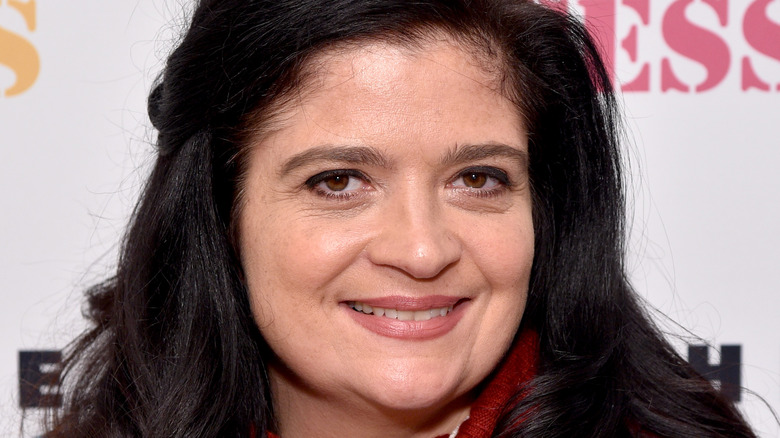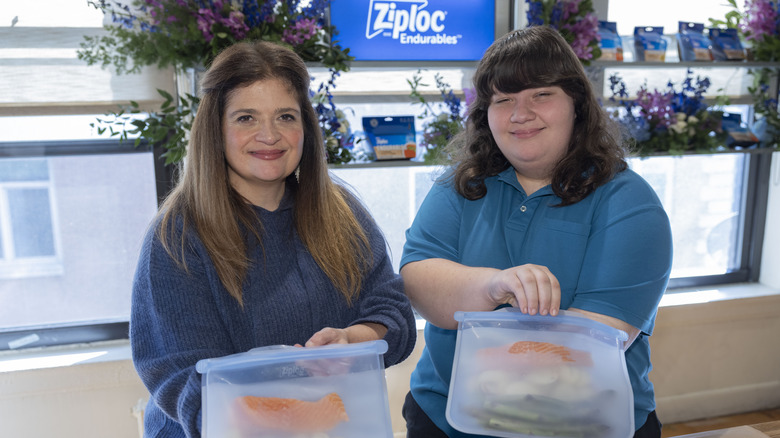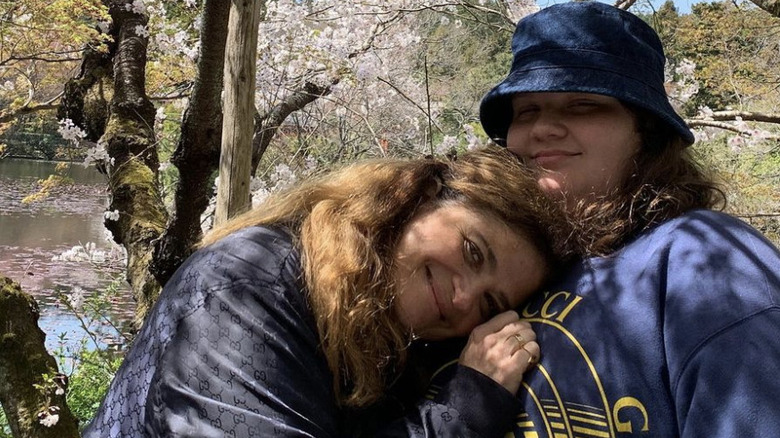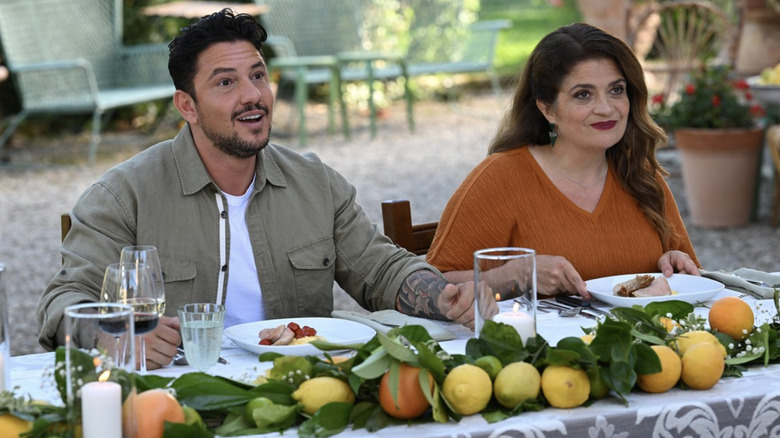Alex Guarnaschelli Spilled The Tea On In-N-Out Vs Shake Shack And Writing Her New Cookbook - Exclusive Interview
Alex Guarnaschelli is busy, and it's easy to understand why. The quick-witted, talented chef is currently a judge on "Ciao House," a host of "Supermarket Stakeout," and has run the award-winning, New York-based restaurant Butter for nearly 20 years. If that weren't impressive enough, Guarnaschelli also just finished a cookbook with her teenage daughter called "Cook It Up: Bold Moves for Family Foods," which will hit bookshelves in September and feature recipes that have been passed down through generations.
She's also promoting her new partnership with Ziploc Endurables, and the charismatic cook told us in an exclusive interview that the reusable silicone bags are the perfect tool to help busy parents like her create easy and delicious meals. She revealed what readers can expect from her new cookbook, what it was like filming "Ciao House" in Italy, and which famous chef gave her the best piece of advice — and she weighed in on the heated Shake Shack versus In-N-Out debate.
What she likes to cook using Ziploc Endurables
What makes Endurable Ziploc bags better to use than other ones when you're cooking?
They add a lot of versatility to what people can do. Number one, they're not single-use, which we know we love — "endurable" implies multiple uses. But also, people can freeze small amounts in the smaller size, like a dinner for one, a lunch for one, whatever that meal is. They can use the bigger bags and pack them up. It's beautiful when you lay the food out in the bag, and you can use these bags in the oven. You can drop these bags in boiling water, which is nuts if you think about it — first of all, the sheer saving on dishes, right?
It encourages, to some extent, lighter cooking because you're not heating up a bunch of oil in a pan and cooking everything there. You could steam stuff. For example, you might've seen my chicken recipe. You could cook rice; you could stir a little pat of butter into the rice or oil or nuts and have it steam. It's almost like cleaner, lighter meals naturally.
These bags eliminate a lot of necessity of things we're used to using all the time that we don't need to lean into so much — like a hot pan filled with oil or other things. That opens up a lot of possibilities that we didn't otherwise have. It also allows for a lot of meal planning.
Do you have a go-to freezer meal or any special dos and don'ts when preparing a freezer meal?
For freezer meals, I like heartier vegetables that can be in the freezer and defrost beautifully — a lot of potatoes, cauliflower, sturdier vegetables, cabbage, things like that. Sweet potatoes, squash — I like those with chicken and a great sauce or pork chops and a great sauce, or even slow-cooked meat: some pork shoulder, some short ribs, some oxtail, even shrimp and some vegetables ... You drop the bag in the hot water, and voila. What I like is the time frame. It takes so much pressure off you to deliver because it's almost like you have something in your back pocket.
What it was like working with her daughter on their new cookbook
I read that you wrote a cookbook called "Cook It Up: Bold Moves for Family Foods" with your daughter Ava. Can you tell me what fans can expect to find it its pages?
It's a combination of things. It's a lot of stuff that Ava and I do because there's some curiosity. What do a chef and her daughter do at home? What's in their pantry? You may want to see a supermodel's closet. You probably want to see a chef's pantry. That's my guess. Or a home decorator's rugs.
Part of the book was sharing a lot of that with people that were definitely curious. The other part was how you can cook with your kids. It's really a matter of what time you can make to cook together for pleasure and what you can do to cook together quickly. Timing is a huge part of it. I grew up in a house with a lot of scratch cooking, and we either ate at a diner or she would spend five hours making beef soup.
There wasn't a lot of middle ground. Ava and I live a lot in the middle ground, which most of modern culture does. Both the Ziploc Endurables and this cookbook hopefully are tools that can diversify that middle ground and not make you feel like it's Groundhog Day with a chicken breast.
What was it like working with your teenage daughter?
I get the obligatory 50 eye rolls, but I got a couple hugs. It's nice. She's the only child, so she's the favorite by default. There's some stuff from her grandmother and there's some stuff from my mother, so both her grandmothers, in the book, made their way organically into the recipes. It's lovely. We're not standing on a bale of hay preaching about farms, and we're not gathered around a table of 50 cousins telling you to eat with your family. But there are whispers of those concepts in a manageable amount for people to think about, because that's a big part of cooking.
Is there a special meaning behind any recipe?
It was funny because Ava makes some stuff with her father's mother; she cooks with her. My mother's unfortunately no longer with us, but her father's mother is. [Ava] has this repertoire of memories from my parents and then these new memories with her other grandparents. She came home and was like, "My Nan likes to make these things. Can we put some of them in the book?" I was like, "Oh, how does she make it?"
Ava is a "pizza bagel," meaning I'm Italian and her father is Jewish. There are multiple cultural traditions that have become the fabric of what Ava's come to know, which I find fascinating. She came home and made latkes and chicken liver and all sorts of stuff that she cooks with her grandmother, which I love; as a native New Yorker, I'm always down for a meal of that nature. I grew up across the street from the Carnegie Deli. That was definitely in my own childhood because I lived in New York. Then she has some other things that she made as an homage to my parents and things that she ate that I didn't even know the impact.
I learned a lot about her, and I know you think, "Really? Who do you know better than your own kid?" You do a project like this and you learn other aspects of them. She's 15. I'm interested to see what her takeaway is as far as what she's witnessed. Because I'm a chef, my relationship to food is a little twisted. I may be a chef and this is something I can do no matter what, but we're also just humans. We're also just a family. Like any other, we come home and it's like, "Oh, God, what is for dinner?" If we don't hurry, we're going to end up eating the rest of these stale crackers with some pickles and some leftover cheese.
What Ciao House was like behind the scenes and what fans can expect from the new season of Supermarket Stakeout
What was it like to film "Ciao House" in Italy?
Italy was beautiful, as you can imagine. Gabriele Bertaccini was a wonderful host. I really enjoyed collaborating with him. He's a Tuscan native, and it was easy and fun to be in Gabriele's hometown with all these chefs. I like that the show was a learning curve and a learning experience for all of them. One of them is going to win the prize of this tremendous learning experience, so I liked that they all got another version of the prize. It wasn't like, "One person's getting everything, and you guys aren't going to get anything."
Were there any unexpected challenges in making the show there?
No, because we were like a family, literally. Gabe and I did not live in the Ciao Houses, but we were down the block, and we were with them a lot. We were with them 12, 14 hours a day. It was beautiful. From the response, it inspires people. People were like, "We're having Tuscan night, and we're cooking a Bistecca alla Fiorentina and watching 'Ciao House.'" I'm like, "This is fantastic." Pop that Bistecca in a Ziploc Endurables and we're all set.
I see that "Supermarket Stakeout" is in the middle of its 5th season. Have there been any interesting moments so far or changes to the show?
We're doing some experiments trying different things, changing the game a little bit to make it interesting. A trend this season has been that chefs are spending $400 in one round, and it's like, "Dude, how are you going to get through two more rounds with just 100 bucks?"
The resourcefulness that ensues — that's been fun to watch because chefs are pirates. You give them money, they'll buy everything — and some of them do. If they would pack some stuff away in Ziploc Endurables and hide it under the counter for the next round, maybe we'd be in better shape. But you can't roll ingredients over, and that is big. What you spend in that round, that's it.
The chef who gave her the best advice and her favorite fast food meal
You've worked with some incredible chefs. Who has given you the best advice?
Probably Bobby [Flay], because he's become a mentor of mine. We need a lot of conversation about confidence and believing in yourself and in your own abilities. That has been my experience. I'm interested in anything that builds confidence. You know when someone says something to you at the right moment and you're like, "How did you even know that kind of feeling?"
He sounds very intuitive. Who is the one chef you'd want to cook dinner for you and why?
Probably Antonia Lofaso. I love her restaurants in California, and I adore her. I think that we're in the mutual admiration society together, so I feel like she would make me something with a lot of love.
What's one ingredient you could never live without?
I cannot function without a jar of Dijon mustard. I'm lost. I know that's weird. I know some people would say some good olive oil or salt or whatever. No — for me it's mustard. You can do anything with mustard.
What are your favorite things to put the mustard in?
For example, slather it on chicken and roast it. You can make a vinaigrette. You can thicken anything with it because it has lecithin, a natural thickener. I've used it in everything. I've used it in a spice cake, barbecue sauce, you name it. If you're eating something I made, it probably has Dijon mustard in it — except for ice cream, maybe.
What is your go-to fast food order, and at which restaurant?
It's got to be a double-double animal [style] at In-N-Out Burger and well-done fries. I like everything on there, and they're like, "Do you want to eat it here?" I'm like, "Nope. I'm going to eat it in my car and I'm going to let ketchup run down my elbow, and I'm going to do the burger hunch over the steering wheel." Maybe it's also because I'm a native New Yorker, so In-N-Out — when I go, if I'm in California — it's got that "you're not at home" food [quality] for me because I can't get it in New York. There's not anything quite like it.
I understand that. I grew up in Southern California, so I miss In-N-Out. We have Shake Shack here, but it's not exactly the same. There's a lot of debate about those two.
For me, there's a big argument. I can go get Shake Shack because I live in New York, so In-N-Out becomes the girl that got away.
I love that it's by the LAX airport too, and you can go right when you land.
I cannot believe you just said that. I literally was about to say to you [that] my favorite is the one on Sepulveda. I land, I get the burger — and actually, it's so close that you can see the planes taking off and landing. I look up and watch the planes take off and land and I have the burger. That's a ritual.
You could buy a bunch and put them in Ziploc Endurables and reheat them ... smuggling in those In-N-Out. Some people are smuggling in fine china and jewelry, and we're smuggling in In-N-Out.
To learn more about Ziploc Endurables, you can visit Ziploc's website.
This interview has been edited for clarity.




